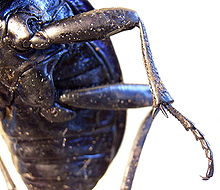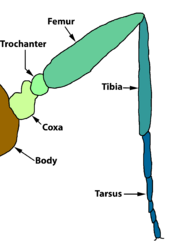Coxa (arthropod)

The term coxa is the scientific name for the hip and is used in arthropods for the uppermost part of the leg . Here the coxa represents the area that is closest to the animal's body.
Often the coxa is fused with the breast plates ( sternites ). In the amphipods it is immobile and forms the coxal plate.
In many spider species , the coxa is not only provided with coxal bristle fields on both sides, but also has special coxal hairs. These form an angle of 60 ° to the coxa and are up to a millimeter long and smooth. They extend to the opposite coxa and serve as proprioceptors in the movement of the legs.
In mites , the supracoxal thorns, which are appendages that lie on the outer ( distal ) rear edge of the coxes, are of systematic importance. In the first pair of coxes there are also such thorns inside.
In a family of the stumpefoots , the Peripatidae , and in the puntipods , the so- called coxal vesicles , also called coxal sacs or coxal organs, are located on the ventral side at the base of the coxae .
In the case of the coxal glands of arachnids , however, only the exits of these glands, which have arisen from the metanephridia , open at the coxes.
See also
- Insect leg
- Split leg
- Vertebrate hip joint
literature
- Rüdiger Wehner, Walter Gehring: Zoology. 24th edition. Georg Thieme Verlag, Stuttgart 2007, ISBN 978-3-13-367424-9 , pp. 742-743.
Individual evidence
- ↑ Friedrich G. Barth : Senses and behavior: from the life of a spider. Springer, Berlin 2000, ISBN 3-540-67716-X , pp. 124-127.
- ↑ Tyler A. Woolley: Acarology. John Wiley & Sons, 1988, ISBN 0-471-04168-8 .
